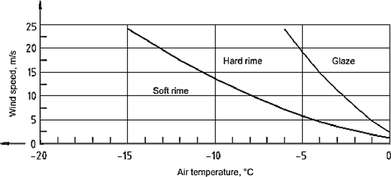Wind

Wind is an important factor in ice formation. The speed and direction of the wind have a great effect on the shape of the icing layer. Wind speed can change what ice type is formed. Wind speed changes the impact velocity, that influences the ice type.
The figure shows how higher wind speeds extend the temperature area for the creation of glaze ice. Wind causes the water droplets to move faster. This prevents them freezing on the surface immediately. This means that glaze can form at a lower temperature. Wind speed also has an effect on the icing rate, not just ice type. In a study by K.J. Sanders and B.L. Barjenbruch [2], ice to water ratio was examined in relation to different wind speed. The study has shown that at wind speeds under 1,5 m/s the ice liquid ratio is 1. When wind speed is above 7.65 m/s, ice to water ratio was 1.9. The study shows a clear increase of icing rate with the increase of wind speed.
References
- ↑ ISO-12494, Atmospheric icing of structures, 2001, 56 p.
- ↑ 2.0 2.1 Sanders, B. (2016). Analysis of Ice-to-Liquid Ratios during Freezing Rain and the Development of an Ice Accumulation Model. Weather and Forecasting, 31(4), 1041–1060.
- ↑ Stenroos, C. (2015) Properties of icephobic surfaces in different icing conditions. https://www.semanticscholar.org/paper/Properties-of-icephobic-surfaces-in-different-icing-Stenroos/d40a044131114b37dbdb41d793ffc849a765a6d8